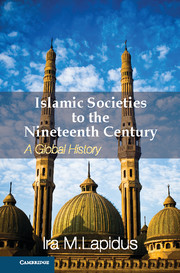Book contents
- Frontmatter
- Contents
- List of Illustrations
- List of Figures
- List of Maps
- List of Tables
- Preface
- Acknowledgments
- Acknowledgments to the first edition of A History of Islamic Societies
- Acknowledgments to the second edition of A History of Islamic Societies
- Publisher's Preface
- Introduction to Islamic Societies
- Part I The Beginnings of Islamic Civilizations
- Part II From Islamic Community to Islamic Society
- Part III The Global Expansion of Islam from the Seventh to the Nineteenth Centuries
- Chapter 25 Introduction: Islamic Institutions
- The Western Islamic Societies
- Chapter 26 Islamic North Africa to the Thirteenth Century
- Chapter 27 Spanish-Islamic Civilization
- Chapter 28 Libya, Tunisia, Algeria, and Morocco from the Thirteenth to the Nineteenth Centuries
- Chapter 29 States and Islam: North African Variations
- Islam in Asia
- Islam in Africa
- Conclusion
- Glossary
- Bibliography
- Annotated Bibliography from A History of Islamic Societies, 2nd Edition
- Index
Chapter 26 - Islamic North Africa to the Thirteenth Century
Published online by Cambridge University Press: 05 February 2013
- Frontmatter
- Contents
- List of Illustrations
- List of Figures
- List of Maps
- List of Tables
- Preface
- Acknowledgments
- Acknowledgments to the first edition of A History of Islamic Societies
- Acknowledgments to the second edition of A History of Islamic Societies
- Publisher's Preface
- Introduction to Islamic Societies
- Part I The Beginnings of Islamic Civilizations
- Part II From Islamic Community to Islamic Society
- Part III The Global Expansion of Islam from the Seventh to the Nineteenth Centuries
- Chapter 25 Introduction: Islamic Institutions
- The Western Islamic Societies
- Chapter 26 Islamic North Africa to the Thirteenth Century
- Chapter 27 Spanish-Islamic Civilization
- Chapter 28 Libya, Tunisia, Algeria, and Morocco from the Thirteenth to the Nineteenth Centuries
- Chapter 29 States and Islam: North African Variations
- Islam in Asia
- Islam in Africa
- Conclusion
- Glossary
- Bibliography
- Annotated Bibliography from A History of Islamic Societies, 2nd Edition
- Index
Summary
From the origins of the Islamic era to the nineteenth century, the history of North African society turned on two essential motifs: state formation and Islamization. Historically the basic units of society – families, hamlets, or groups of hamlets – were embedded in factional and tribal groups. The economy was based on small-scale grain, fruit, and olive production; stock raising by pastoral peoples; and limited urban-based textile and other small-scale manufacturing. Although trade was important, the merchant middle class was not highly developed. Unlike the Middle East, North Africa did not have a long experience of imperial organization, monotheistic religious communities, sedentarized agriculture, and urban commerce. It had a veneer of imperial and urban Christian civilization set down by the Phoenicians and Romans, and confined to relatively limited coastal territories.
Islamic civilization was brought to North Africa and Spain by the Arab conquests in the seventh and eighth centuries. The Arab conquests led to the formation of not one but several political centers, and an ever-changing political geography. North African forces conquered Spain in the eighth century. From the seventh to the eleventh centuries, North Africa and Spain were divided among governments formed by the Arab conquerors, by Berber tribes, or by Arab-Berber coalitions. The smaller Berber kingdoms defined themselves in varying forms of Khariji Islam, while the Umayyad dynasty in Spain and the Fatimids in North Africa claimed to be the caliphs of the whole Islamic world.
- Type
- Chapter
- Information
- Islamic Societies to the Nineteenth CenturyA Global History, pp. 369 - 381Publisher: Cambridge University PressPrint publication year: 2012



